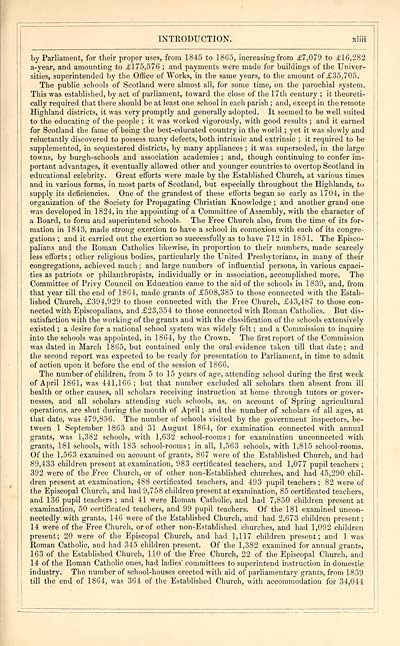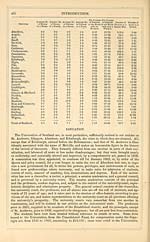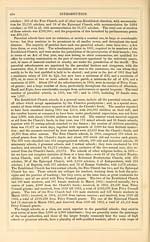Imperial gazeteer of Scotland, or, Dictionary of Scottish topography > Volume 1
(57) Page xliii
Download files
Complete book:
Individual page:
Thumbnail gallery: Grid view | List view

INTRODUCTION. xliii
by Parliament, for their proper uses, from 1845 to 1865, increasing from .£7,079 to .£16,282
a-year, and amounting to .£175,576 ; and payments were made for buildings of the Univer-
sities, superintended by the Office of Works, in the same years, to the amount of £35,705.
The public schools of Scotland were almost all, for some time, on the parochial system.
This was established, by act of parliament, toward the close of the 17th century ; it theoreti-
cally required that there should be at least one school in each parish ; and, except in the remote
Highland districts, it was very promptly and generally adopted. It seemed to be well suited
to the educating of the people ; it was worked vigorously, with good results ; and it earned
for Scotland the fame of being the best-educated country in the world ; yet it was slowly and
reluctantly discovered to possess many defects, both intrinsic and extrinsic ; it required to be
supplemented, in sequestered districts, by many appliances ; it was superseded, in the large
towns, by burgh-schools and association academies ; and, though continuing to confer im-
portant advantages, it eventually allowed other and younger countries to overtop Scotland in
educational celebrity. Great efforts were made by the Established Church, at various times
and in various forms, in most parts of Scotland, but especially throughout the Highlands, to
supply its deficiencies. One of the grandest of these efforts began so early as 1704, in the
organization of the Society for Propagating Christian Knowledge ; and another grand one
■was developed in 1824, in the appointing of a Committee of Assembly, with the character of
a Board, to form and superintend schools. The Pree Church also, from the time of its for-
mation in 1843, made strong exertion to have a school in connexion with each of its congre-
gations ; and it carried out the exertion so successfully as to have 712 in 1851. The Episco-
palians and the Roman Catholics likewise, in proportion to their numbers, made scarcely
less efforts ; other religious bodies, particularly the United Presbyterians, in many of their
congregations, achieved much ; and large numbers of influential persons, in various capaci-
ties as patriots or philanthropists, individually or in association, accomplished more. The
Committee of Privy Council on Education came to the aid of the schools in 1839, and, from
that year till the end of 1864, made grants of £508,3S5 to those connected with the Estab-
lished Church, £394,929 to those connected with the Pree Church, £43,487 to those con-
nected with Episcopalians, and £23,354 to those connected with Roman Catholics. But dis-
satisfaction with the working of the grants and with the classification of the schools extensively
existed ; a desire for a national school system was widely felt ; and a Commission to inquire
into the schools was appointed, in 1864, by the Crown. The first report of the Commission
■was dated in March 1865, but contained only the oral-evidence taken till that date; and
the second report was expected to be ready for presentation to Parliament, in time to admit
of action upon it before the end of the session of 1866.
The number of children, from 5 to 15 years of age, attending school during the first week
of April 1861, was 441,166; but that number excluded all scholars then absent from ill
health or other causes, all scholars receiving instruction at home through tutors or gover-
nesses, and all scholars attending such schools, as, on account of Spring agricultural
operations, are shut during the month of April ; and the number of scholars of all ages, at
that date, was 479,856. The number of schools visited by the government inspectors, be-
tween 1 September 1863 and 31 August 1864, for examination connected with annual
grants, was 1,382 schools, with 1,632 school-rooms; for examination unconnected with
grants, 181 schools, with 183 school-rooms; in all, 1,563 schools, with 1,815 school-rooms.
Of the 1,563 examined on account of grants, 867 were of the Established Church, and had
89,433 children present at examination, 983 certificated teachers, and 1,077 pupil teachers ;
392 were of the Pree Church, or of other non-Established churches, and had 45,290 chil-
dren present at examination, 488 certificated teachers, and 493 pupil teachers; 82 were of
the Episcopal Church, and had 9,758 children present at examination, 85 certificated teachers,
and 136 pupil teachers; and 41 were Roman Catholic, and had 7,850 children present at
examination, 50 certificated teachers, and 99 pupil teachers. Of the 181 examined uncon-
nectedly with grants, 146 were of the Established Church, and had 2,673 children present;
14 were of the Free Church, or of other non-Established churches, and had 1,092 children
present; 20 were of the Episcopal Church, and had 1,117 children present; and 1 was
Roman Catholic, and had 345 children present. Of the 1,382 examined for annual grants,
163 of the Established Church, 110 of the Pree Church, 22 of the Episcopal Church, and
14 of the Roman Catholic ones, had ladies' committees to superintend instruction in domestic
industry. The number of school-houses erected with aid of parliamentary grants, from 1839
till the end of 1864, was 364 of the Established Church, with accommodation for 34,044
by Parliament, for their proper uses, from 1845 to 1865, increasing from .£7,079 to .£16,282
a-year, and amounting to .£175,576 ; and payments were made for buildings of the Univer-
sities, superintended by the Office of Works, in the same years, to the amount of £35,705.
The public schools of Scotland were almost all, for some time, on the parochial system.
This was established, by act of parliament, toward the close of the 17th century ; it theoreti-
cally required that there should be at least one school in each parish ; and, except in the remote
Highland districts, it was very promptly and generally adopted. It seemed to be well suited
to the educating of the people ; it was worked vigorously, with good results ; and it earned
for Scotland the fame of being the best-educated country in the world ; yet it was slowly and
reluctantly discovered to possess many defects, both intrinsic and extrinsic ; it required to be
supplemented, in sequestered districts, by many appliances ; it was superseded, in the large
towns, by burgh-schools and association academies ; and, though continuing to confer im-
portant advantages, it eventually allowed other and younger countries to overtop Scotland in
educational celebrity. Great efforts were made by the Established Church, at various times
and in various forms, in most parts of Scotland, but especially throughout the Highlands, to
supply its deficiencies. One of the grandest of these efforts began so early as 1704, in the
organization of the Society for Propagating Christian Knowledge ; and another grand one
■was developed in 1824, in the appointing of a Committee of Assembly, with the character of
a Board, to form and superintend schools. The Pree Church also, from the time of its for-
mation in 1843, made strong exertion to have a school in connexion with each of its congre-
gations ; and it carried out the exertion so successfully as to have 712 in 1851. The Episco-
palians and the Roman Catholics likewise, in proportion to their numbers, made scarcely
less efforts ; other religious bodies, particularly the United Presbyterians, in many of their
congregations, achieved much ; and large numbers of influential persons, in various capaci-
ties as patriots or philanthropists, individually or in association, accomplished more. The
Committee of Privy Council on Education came to the aid of the schools in 1839, and, from
that year till the end of 1864, made grants of £508,3S5 to those connected with the Estab-
lished Church, £394,929 to those connected with the Pree Church, £43,487 to those con-
nected with Episcopalians, and £23,354 to those connected with Roman Catholics. But dis-
satisfaction with the working of the grants and with the classification of the schools extensively
existed ; a desire for a national school system was widely felt ; and a Commission to inquire
into the schools was appointed, in 1864, by the Crown. The first report of the Commission
■was dated in March 1865, but contained only the oral-evidence taken till that date; and
the second report was expected to be ready for presentation to Parliament, in time to admit
of action upon it before the end of the session of 1866.
The number of children, from 5 to 15 years of age, attending school during the first week
of April 1861, was 441,166; but that number excluded all scholars then absent from ill
health or other causes, all scholars receiving instruction at home through tutors or gover-
nesses, and all scholars attending such schools, as, on account of Spring agricultural
operations, are shut during the month of April ; and the number of scholars of all ages, at
that date, was 479,856. The number of schools visited by the government inspectors, be-
tween 1 September 1863 and 31 August 1864, for examination connected with annual
grants, was 1,382 schools, with 1,632 school-rooms; for examination unconnected with
grants, 181 schools, with 183 school-rooms; in all, 1,563 schools, with 1,815 school-rooms.
Of the 1,563 examined on account of grants, 867 were of the Established Church, and had
89,433 children present at examination, 983 certificated teachers, and 1,077 pupil teachers ;
392 were of the Pree Church, or of other non-Established churches, and had 45,290 chil-
dren present at examination, 488 certificated teachers, and 493 pupil teachers; 82 were of
the Episcopal Church, and had 9,758 children present at examination, 85 certificated teachers,
and 136 pupil teachers; and 41 were Roman Catholic, and had 7,850 children present at
examination, 50 certificated teachers, and 99 pupil teachers. Of the 181 examined uncon-
nectedly with grants, 146 were of the Established Church, and had 2,673 children present;
14 were of the Free Church, or of other non-Established churches, and had 1,092 children
present; 20 were of the Episcopal Church, and had 1,117 children present; and 1 was
Roman Catholic, and had 345 children present. Of the 1,382 examined for annual grants,
163 of the Established Church, 110 of the Pree Church, 22 of the Episcopal Church, and
14 of the Roman Catholic ones, had ladies' committees to superintend instruction in domestic
industry. The number of school-houses erected with aid of parliamentary grants, from 1839
till the end of 1864, was 364 of the Established Church, with accommodation for 34,044
Set display mode to: Large image | Transcription
Images and transcriptions on this page, including medium image downloads, may be used under the Creative Commons Attribution 4.0 International Licence unless otherwise stated. ![]()
| Gazetteers of Scotland, 1803-1901 > Imperial gazeteer of Scotland, or, Dictionary of Scottish topography > Volume 1 > (57) Page xliii |
|---|
| Permanent URL | https://digital.nls.uk/97459814 |
|---|
| Description | Volume I: Aan-Gordon. |
|---|---|
| Attribution and copyright: |
|

